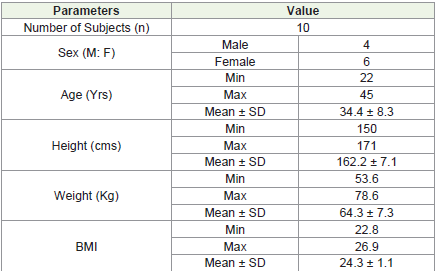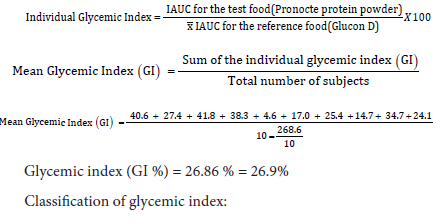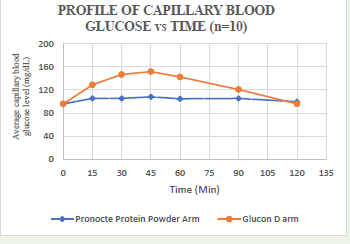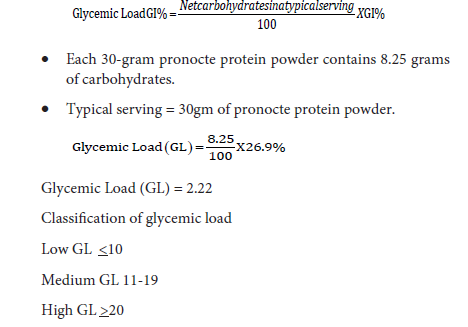Research Article
Determination of Glycemic Index and Glycemic Load of Pronocte Protein Powder in Healthy Human Adult Subjects, Under Fasting Conditions
Shobha JC* and Rao PV
Department of Clinical Research, Hetero Healthcare Ltd., Hyderabad, India
*Corresponding author:Shobha JC, Head of Department (HOD), Department of Clinical Research, Hetero Healthcare Ltd., Hyderabad, India. Email Id: Shobhaudutha@gmail.com
Article Information:Submission: 22/05/2024; Accepted: 28/06/2024; Published: 04/07/2024
Copyright: ©2024 Shobha JC, et al. This is an open access article distributed under the Creative Commons Attribution License, which permits unrestricted use, distribution, and reproduction in any medium, provided the original work is properly cited.
Abstract
Study background: Malnutrition, particularly micronutrient deficits, is common among cirrhotic patients, necessitating interventions to preserve
muscle mass. Late-evening snacks with specific nutritional content are crucial for this population. The pronocte protein powder was developed with
nutritional value.
Objective: To investigate the glycemic index and glycemic load of pronocte protein powder in healthy human adult participants during fasting
conditions.
Methods: This was a single-center study, 13 healthy human adult subjects participated, and the data is available for 10 subjects. The study was
conducted as per the recommendations of WHO.
Results: The peak capillary blood glucose was 108.2±12.9 mg/dL at 45 min in the test group (Pronocte protein powder) and 151.7±23.6 mg/dL
at 45 min in the reference group (Glucon-D). The mean blood glucose incremental area under the curve for the test group was 1056.1 mg.min/dL
and for the reference group 3932.3 mg.min/dL.
Conclusion: The glycemic index of pronocte protein powder was 26.9% which is low as per GI classification. The glycemic load is 2.22 per
typical serving of 30gm which is low as per the classification of glycemic load. Pronocte protein powder can serve as a late-night snack. This will
prevent the catabolic phase in cirrhosis patients..
Keywords:Malnutrition; Pronocte Protein Powder; Glucon-D; Glycemic Index; Glycemic Load; Cirrhosis
Introduction
Malnutrition or alterations in certain aspects of nutritional
status, such as micronutrient deficits driven by various mechanisms,
including poor nutritional intake and absorption or increased losses
are commonly seen in patients with various conditions. Muscle
atrophy and sarcopenia are among the most serious concerns in
cirrhosis patients. Patients with cirrhosis frequently enter a catabolic
phase overnight due to a lack of glycogen stores in the liver. Cirrhotic
patients must preserve muscular mass [1].
One strategy to accomplish this is to eat a late-night snack that
can aid in avoiding the formation of a catabolic phase with muscle
loss.[1] Overnight fasting of cirrhotic patients has a similar effect to 3
days of fasting in a normal individual [2].
Nocturnal supplementation is recommended by both the
American Society for Parenteral and Enteral Nutrition and the
European Society for Clinical Nutrition and Metabolism guidelines
to avoid increased utilization of lean body stores to meet energy
needs in fasted patients suffering from liver cirrhosis. Late-evening
/ night snacks having various nutritional content (rich in branched chain
amino acids (BCAA) and/or carbohydrates) have been
demonstrated to ameliorate the extent to which fat and nitrogen are
utilized in the fasted state in patients with liver cirrhosis and improve
overall nitrogen balance and living standard[3].
The administration of a carbohydrate-based nutritional course
that is gradually digested and absorbed could potentially compensate
for deterioration in liver function, thereby supporting higher
utilization of this substrate for energy needs in the fasting state. Foods
with low glycemic index are typically absorbed more slowly overnight,
which may result in increased carbohydrate utilization and reduced
fat and protein mobilization from the adipocyte and lean tissue [3].
The glycemic index is a scale that helps rank carbohydrate containing
foods, depending on how they affect the blood glucose
levels in 2-3 hours after having food/food product as compared to
pure glucose, which is assigned a glycemic index value of 100 [4].
Glycemic load is a more effective predictor of whether the meal
consumed in a typical (recommended) serving is healthy or not.[5]
Pronocte protein powder was developed by Azista Industries Pvt
Ltd. an associate of Hetero Healthcare Ltd as a late evening/night
snack to prevent the development of catabolic phase with muscle loss
mostly in people with hepatic cirrhosis.
Nutritional science revolves around the concept of food as
medicine. Natural products are becoming more vital for treating
medical issues. The idea of food as medicine inspired the innovation
of pronocte protein powder. The current study was conducted to
determine the glycemic index and glycaemic load of pronocte protein
powder in healthy human adult volunteers under fasting conditions,
which would be utilized as a late evening/night snack by cirrhosis
patients.
Materials and Methods
Subjects fulfilling the inclusion and exclusion criteria and willing
to participate in the clinical study were included in the study after
obtaining their written informed consent. This study was approved
by the Institutional Ethics Committee, Ramdev Rao Hospital,
Hyderabad. This trial was registered at Clinical Trail Registry-India
(CTRI Number- CTRI/2022/02/040477) before initiating the study.
At baseline, the demographic data (age, gender, height, weight, BMI),
and vitals were recorded along with clinical examination.
After an overnight fast of 8-10 hours, on the day of the study [6],
during period 1, subjects received either pronocte protein powder
or glucon D as per randomization. After the washout phase of 2-3
days, during period 2, those subjects who consumed pronocte protein
powder during period 1 received and consumed glucon D and vice
versa. (i.e., the subjects were crossed over during the period 2). At the
end of period 2, all the subjects received both study products.
Each subject received and consumed 182 grams of pronocte
protein powder (equivalent to 50 grams of glucose) or 50 grams of
glucon D with 240 ml of water during each study period (Period 1 and
Period 2) as per randomization. The study products were consumed
within the time frame of 10-12 min. The subjects were restricted
from performing any physical activity during the 2 hours of the study
period.
Baseline fasting capillary blood glucose levels were recorded
using a glucometer (Freestyle optium). Capillary blood samples were
for determining blood glucose using a glucometer at 7-time points
i.e. at fasting state 30 mins before consumption of study product
(considered as 0 min), 15 min, 30 min, 45 min, 60 min, 90 min, and
120 minutes after completion of study product consumption [7].
The compliance was recorded by the study nurse after the
complete consumption of the study product (Pronocte protein
powder / Glucon-D). Vital parameters were recorded along with any
undesirable effects developed, during the entire study period. Standard
summary statistics (arithmetic mean and standard deviation) were
calculated for demographics and vital parameters.
Blood glucose curves were constructed from capillary blood
glucose values for each subject at time 0, 15, 30, 45, 60, 90, and
120-minute intervals after consumption of the test product (Pronocte
protein powder) or reference product (Glucon D). The incremental
area under the curve (IAUC) was calculated by the trapezoidal rule
in every subject separately [8], as the sum of the surface of trapezoids
between the blood glucose curve and horizontal baseline going
parallel to X axis from the beginning of blood glucose curve at time
0 to the point at 120 min to reflect the total rise in blood glucose
concentration after consuming the reference food (Glucon D) and
test food (Pronocte protein powder). The mean IAUC for all 10
subjects for reference product (Glucon D) and test product (Pronocte
protein powder) were calculated.
The Individual glycemic index (GI) was calculated as=
IAUC for the test food*100
x IAUC for the reference food
The calculation of glycemic load (GL) i.e., the impact that the
carbohydrate-containing food has on blood sugar. GL = GI (%) x
grams of carbohydrate in the typical serving of food eaten. GL would
be the sum of the GL of each food that is part of the food.
Glycemic Load( GL)=Net carbohydrates in a typical serving x GI
100
Safety variables were recorded during the entire study period.
Results
Out of 13 subjects enrolled, 3 were outliers and were eliminated
from the analysis. Demographic data is available for 10 subjects. Out
of 10 subjects, 4 were males and 6 were females, the mean age was 34.4
± 8.3yrs, and the mean height, weight, and BMI was 162.2 ± 7.1cms,
64.3 + 7.3 Kgs and 24.3 + 1.1 respectively.
The capillary blood glucose response from 0 min to 120 min with
the test product (Pronocte protein powder) and reference product
(Glucon-D). The mean fasting capillary blood glucose was 95.8 ± 7.1
mg/dL in the test group and 96.0 ±8.3mg/dL in the reference group at
baseline (0 min). The peak capillary blood glucose of 108.2±12.9 mg/
dL was at 45 min in the test group and 151.7±23.6 mg/dL at 45 min
in the reference group.
The mean capillary blood glucose response with test and reference
products (mg/dL) is shown in [Figure 1].
The incremental area under the curve and individual glycemic
index (GI) was calculated.
Low GI <55%
Medium GI 56 – 69%
High GI >70%
Thus, the glycemic index of the test product (Pronocte protein
powder) 26.9 % is low GI.
Glycemic load:
The Glycemic load was calculated as the GI (%) multiplied by
the grams of carbohydrate in the typical serving scoop of 30 gm of
pronocte protein powder. The GL for a food would be the sum of the
GL of each food that is part of the food, and GL was calculated by the
formula:Thus, the glycemic load of the test product (pronocte protein
powder) in a typical serving of 30 gm is 2.22 low.
The glycemic load is a better predictor of whether the food eaten
in moderate (recommended) servings is healthy or not.
The test and reference products were tolerated without any
adverse events.
Discussion
Liver cirrhosis is a major health issue with a high morbidity and
mortality rate around the world. Cirrhotic individuals have aberrant
metabolism, including enhanced fat oxidation, reduced glucose
oxidation and protein energy deficiency which are the primary causes
of poor prognosis.
Cirrhotic people who are malnourished have visceral protein
sources depleted by up to 80%. Protein is recognized as a significant
component of the diet in cirrhosis and is particularly important to
avoid malnutrition and tissue wasting. Tissue loss and muscle wastage
will persist unless these nutrients are reintroduced into the body [9].
New recommendations have been proposed by researchers
studying the protein requirements of cirrhotic patients that have
changed practice guidelines. Patients with cirrhosis should consume
1.0-1.5 g/kg protein per day to prevent muscle catabolism [10].
Researchers have also suggested that eating a carbohydrate
and protein-rich nighttime snack may aid with nitrogen balance,
muscular cramping, and muscle breakdown by providing the body
with carbohydrate energy overnight and avoiding gluconeogenesis.
Patients with liver cirrhosis were advised to have a late-night snack to
alleviate their morning hunger.
It is recommended by researchers that a simple addition of protein
and carbohydrate-rich late evening snacks help preserve nitrogen
balance and improve and prevent muscle cramps and breakdown
by providing the body with carbohydrate energy and preventing
gluconeogenesis [10].
Recent progressive studies showed that late evening snacks had
various physiological effects such as antihypertension, obesity, and
anti-amnesia properties and that helps in maintaining a greater
health-related quality of life (QOL) for patients with cirrhosis.
Late evening snack holds the promise as an intervention to
reverse anabolic resistance and sarcopenia of cirrhosis with improved
quality of life in patients with cirrhosis. Late evening snacks should
be considered as an appropriate nutrition support for people with
cirrhosis [11].
The present study provides valuable insights into the potential
role of pronocte protein powder as a late-night snack for patients with
cirrhosis and other health conditions prone for muscle loss. Its low
glycemic index and load make it a promising option for preventing
the catabolic phase and preserving muscle mass.
Conclusion
In the present study, the glycemic index of pronocte protein
powder is low (26.9%) and the glycemic load of 2.22 per typical
serving of 30gm is also low. Consuming the recommended serving
scoop of 30 gm will help in preventing sarcopenia in patients with
cirrhosis and various other health conditions. A low glycemic index
will help reduce fat and protein mobilization from adipocyte and
lean tissue and increase carbohydrate utilization. The study findings
provide valuable data for developing nutritional interventions to
manage unique nutritional challenges faced by patients with medical
conditions.
Acknowledgement
This research was sponsored by a grant from Hetero Healthcare
Ltd. Our thanks and appreciation go to Ms. Ravina Nakka and Mr.
P. Narender Reddy [Clinical Research Associate] for helping in the
preparation of the manuscript and analyzing the data by providing
technical support in the preparation of the manuscript.





